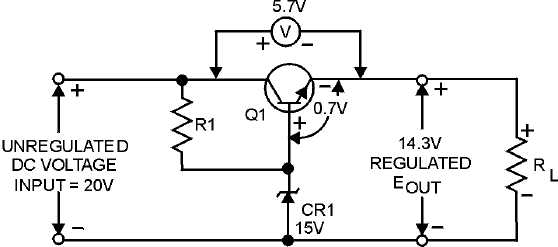4-40
Figure 4-34.—Series voltage regulator.
Recall that a Zener diode is a diode that block current until a specified voltage is applied. Remember
also that the applied voltage is called the breakdown, or Zener voltage. Zener diodes are available with
different Zener voltages. When the Zener voltage is reached, the Zener diode conducts from its anode to
its cathode (with the direction of the arrow).
In this voltage regulator, Q1 has a constant voltage applied to its base. This voltage is often called
the reference voltage. As changes in the circuit output voltage occur, they are sensed at the emitter of Q1
producing a corresponding change in the forward bias of the transistor. In other words, Q1 compensates
by increasing or decreasing its resistance in order to change the circuit voltage division.
Now, study figure 4-35. Voltages are shown to help you understand how the regulator operates. The
Zener used in this regulator is a 15-volt Zener. In this instance the Zener or breakdown voltage is 15 volts.
The Zener establishes the value of the base voltage for Q1. The output voltage will equal the Zener
voltage minus a 0.7-volt drop across the forward biased base-emitter junction of Q1, or 14.3 volts.
Because the output voltage is 14.3 volts, the voltage drop across Q1 must be 5.7 volts.
Figure 4-35.—Series voltage regulator (with voltages).
Study figure 4-36, view A, in order to understand what happens when the input voltage exceeds 20
volts. Notice the input and output voltages of 20.1 and 14.4 volts, respectively. The 14.4 output voltage is
a momentary deviation, or variation, from the required regulated output voltage of 14.3 and is the result of
a rise in the input voltage to 20.1 volts. Since the base voltage of Q1 is held at 15 volts by CR1, the



